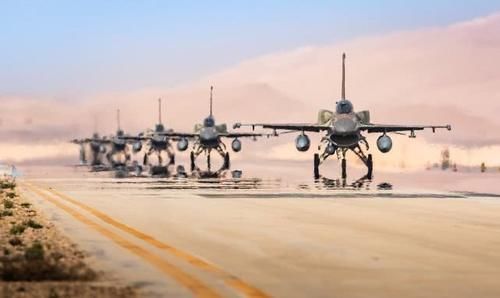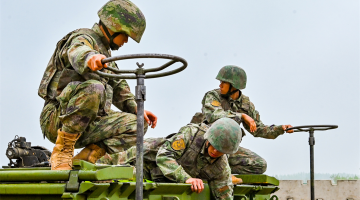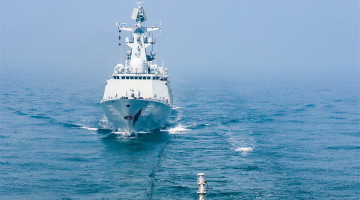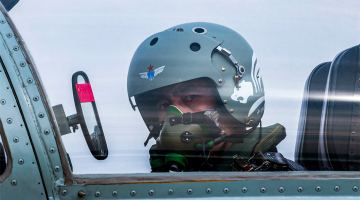
By Shu Meng
The 12-day-long Blue Flag multinational joint air force exercise in Israel concluded on November 14. The Blue Flag is a biennial military exercise first held in 2013, and the one this year was held at the Ovda Air Force Base, southern Israel. More than 1,000 soldiers from the US, Germany, Italy and Greece participated in it, and many other countries sent observer groups.
This year’s Blue Flag joint air force exercise had two major characteristics compared with previous ones.
First of all, the subjects were closer to real combat. The exercise subjects this year were quite complicated, including air-to-air battle, air-to-ground battle and ground-air missile threat response. The Israeli Air Force and its foreign counterparts flew tens of times to simulate ground-air battle scenarios and collect information for joint response to ground-to-air missiles and joint operations on enemy territory. Israel’s military exercises in recent years have become increasingly realistic. In June this year, it held the largest-scale exercise since 2017 that simulated how to cope with underground cross-border attacks from Lebanon.
Second, several F-35 warplanes participated in the exercise. It is a fifth-generation multi-purpose warplane developed by the US and some allies that can be used to support frontline operations, bomb targets and perform air-defense interceptions. Israel had its first F-35 at the end of 2016 and is expected to have as many as 50 of them by 2024 to form two squadrons. One of the main purposes of the Blue Flag exercise this year was trying the F-35 warplane, and all of Israel’s F-35s and some assigned by the US, Germany and Italy formed a powerful fleet.
F-35 is of great importance for the Israeli Air Force and national defense. It has been called stealth warplane because of its good stealth performance against regular radars and the ability to fly at hypervelocity while carrying ammunition. After it was commissioned to real combat by Israel in 2018, the warplane has flown to Syria and Lebanon as well as Iranian hinterland without triggering early warning of the local air defense system. Although some military expert claimed earlier that it would take some time for F-35 to merge with Israel’s military communication and weapon system, it seems that Israel is already capable of integrating the warplane with its existing combat system and turning its performance advantages into combat force. A direct purpose of the exercise was reinforcing that capability and cooperating with the US and other countries to regularize the combined use of F-35 in real combat.
Apart from direct purposes, the military exercise also had two potential goals:
The first one was maintaining overwhelming air force superiority in the region. Israel has superior national defense and military forces in the Middle East. Its air force, which got famous after the Six Day war in 1967, made a special point of safeguarding its security through the inter-generational performance advantage of weapons. However, one of its F-16 warplane was shot down by Syrian air defense troops in February 2018, and during its air raid of Syria, Russia delivered the S-300 air defense missile system to Syria, which somewhat undermined its superiority. Moreover, Israel believed in “attack is the best defense”. When its superiority over regional rivals is weakened, it’s necessary to upgrade its weapons and enhance their capability through realistic training.
The second was imposing pressure on Iran. Israel always takes Iran as the main threat in the region, which is in grave tension right now due to the escalation of the Iranian nuclear issue. After the US cut its input in the Middle East, Israel has felt a growing sense of insecurity from Iran, so its military has continuously increased the defense budget on the excuse of mounting threat from it. For instance, Israeli Prime Minister Netanyahu claimed “Iran is trying to besiege and threaten Israel”. Iran is rather backward in air defense network and electronic warfare, so F-35 warplane can penetrate to its hinterland without flying over neither Saudi nor Iraqi military bases and be a “trump car” in the potential conflict with it. The high-profile exercise of F-35 warplanes this time demonstrated Israel’s capability of hitting hinterland targets in Iran and also aligned itself with America’s “maximum pressure” policy against the Islamic country.
Nevertheless, given the current stalemate between the US and Iran, Israel’s military exercise will have negative impacts on the regional situation. The actual-combat exercises participated by so many F-35 warplanes can flex muscles and deter the rival, but it will also aggravate regional security. In fact, neither party wants to see a minor incident sparking a conflict.
(The author is an assistant researcher at the Middle East Studies Institute of the Shanghai International Studies University)









